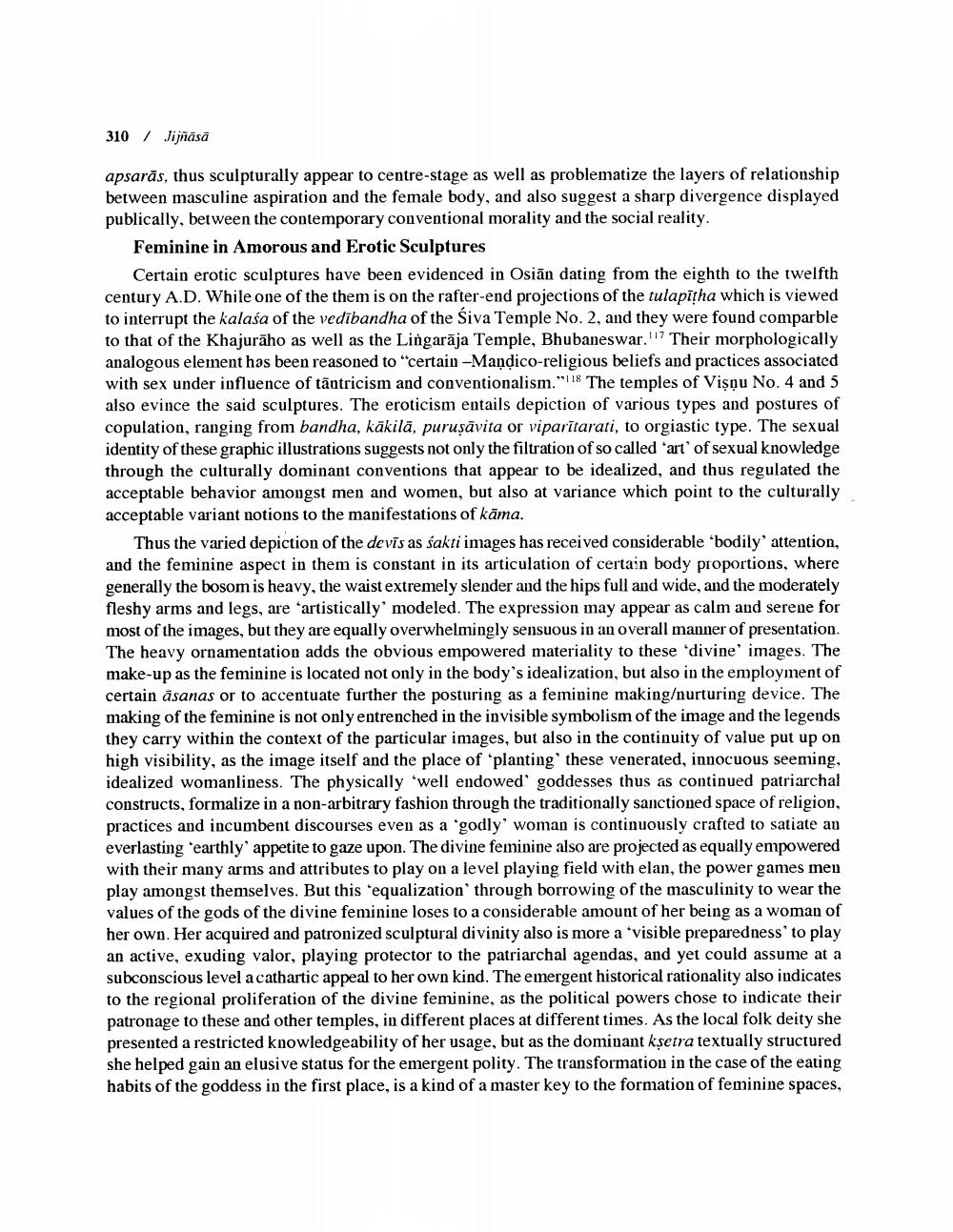________________
310 / Jijñāsā
apsaras, thus sculpturally appear to centre-stage as well as problematize the layers of relationship between masculine aspiration and the female body, and also suggest a sharp divergence displayed publically, between the contemporary conventional morality and the social reality.
Feminine in Amorous and Erotic Sculptures
Certain erotic sculptures have been evidenced in Osian dating from the eighth to the twelfth century A.D. While one of the them is on the rafter-end projections of the tulapitha which is viewed to interrupt the kalasa of the vedībandha of the Siva Temple No. 2, and they were found comparble to that of the Khajuraho as well as the Lingaraja Temple, Bhubaneswar. Their morphologically analogous element has been reasoned to "certain -Mandico-religious beliefs and practices associated with sex under influence of tantricism and conventionalism."118 The temples of Viṣṇu No. 4 and 5 also evince the said sculptures. The eroticism entails depiction of various types and postures of copulation, ranging from bandha, kākilā, puruṣāvita or viparitarati, to orgiastic type. The sexual identity of these graphic illustrations suggests not only the filtration of so called 'art' of sexual knowledge through the culturally dominant conventions that appear to be idealized, and thus regulated the acceptable behavior amongst men and women, but also at variance which point to the culturally acceptable variant notions to the manifestations of kāma.
Thus the varied depiction of the devīs as sakti images has received considerable 'bodily' attention, and the feminine aspect in them is constant in its articulation of certain body proportions, where generally the bosom is heavy, the waist extremely slender and the hips full and wide, and the moderately fleshy arms and legs, are ‘artistically' modeled. The expression may appear as calm and serene for most of the images, but they are equally overwhelmingly sensuous in an overall manner of presentation. The heavy ornamentation adds the obvious empowered materiality to these 'divine' images. The make-up as the feminine is located not only in the body's idealization, but also in the employment of certain asanas or to accentuate further the posturing as a feminine making/nurturing device. The making of the feminine is not only entrenched in the invisible symbolism of the image and the legends they carry within the context of the particular images, but also in the continuity of value put up on high visibility, as the image itself and the place of 'planting' these venerated, innocuous seeming, idealized womanliness. The physically 'well endowed' goddesses thus as continued patriarchal constructs, formalize in a non-arbitrary fashion through the traditionally sanctioned space of religion, practices and incumbent discourses even as a 'godly' woman is continuously crafted to satiate an everlasting earthly' appetite to gaze upon. The divine feminine also are projected as equally empowered with their many arms and attributes to play on a level playing field with elan, the power games men play amongst themselves. But this 'equalization' through borrowing of the masculinity to wear the values of the gods of the divine feminine loses to a considerable amount of her being as a woman of her own. Her acquired and patronized sculptural divinity also is more a 'visible preparedness' to play an active, exuding valor, playing protector to the patriarchal agendas, and yet could assume at a subconscious level a cathartic appeal to her own kind. The emergent historical rationality also indicates to the regional proliferation of the divine feminine, as the political powers chose to indicate their patronage to these and other temples, in different places at different times. As the local folk deity she presented a restricted knowledgeability of her usage, but as the dominant kṣetra textually structured she helped gain an elusive status for the emergent polity. The transformation in the case of the eating habits of the goddess in the first place, is a kind of a master key to the formation of feminine spaces,




